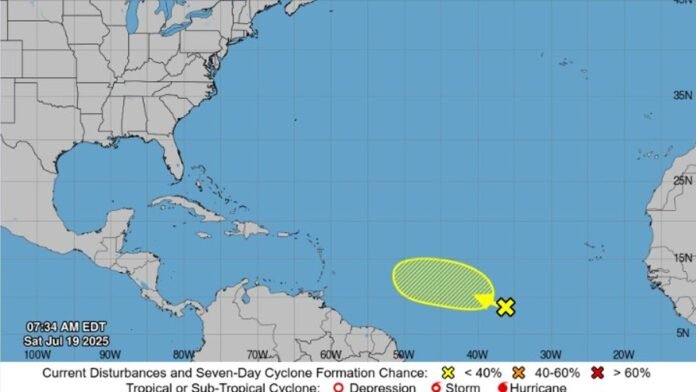A tropical wave is interacting with a broad low pressure area to produce the showers and thunderstorms in the open Atlantic Ocean.

How to prepare for a hurricane
It’s important to take these steps before hurricane season.
The National Hurricane Center is watching some disorganized showers and thunderstorms east of the Caribbean that have slight odds of forming into a tropical cyclone, a July 19 outlook says.
A tropical wave is interacting with a broad low pressure area to produce the showers and thunderstorms in the open Atlantic Ocean, more than 900 miles southwest of the Cabo Verde Islands, off of Africa, forecasters said.
“Environmental conditions appear marginally conducive for gradual development of this system during the next few days as it moves westward to north-westward around 10 mph,” the center, part of the National Weather Service, said in an update.
By the middle of next week, conditions are expected to become unfavorable for the system to develop, forecasters said. AccuWeather said the pattern is expected to be met with wind shear approaching the Caribbean Sea, which could limit the system from intensifying.
The Atlantic hurricane season officially began on June 1 and will last through the end of November.
Active hurricane weather typically peaks between mid-August and mid-October.
Atlantic hurricane season storm tracker
How do hurricanes form?
Hurricanes are born in the tropics, above warm water. Clusters of thunderstorms can develop over the ocean when water temperatures exceed 80 degrees Fahrenheit. If conditions are right, the clusters swirl into a storm known as a tropical wave or tropical depression.
A tropical depression becomes a named tropical storm once its sustained wind speeds reaches 39 miles per hour. When its winds reach 74 mph, the storm officially becomes a hurricane.
Prepare now for hurricanes
Delaying potentially life-saving preparations could mean waiting until it’s too late. “Get your disaster supplies while the shelves are still stocked, and get that insurance checkup early, as flood insurance requires a 30-day waiting period,” NOAA recommends.
- Develop an evacuation plan: If you are at risk from hurricanes, you need an evacuation plan. Now is the time to begin planning where you would go and how you would get there.
- Assemble disaster supplies: Whether you’re evacuating or sheltering-in-place, you’re going to need supplies not just to get through the storm but for the potentially lengthy aftermath, NOAA said.
- Get an insurance checkup and document your possessions: Contact your insurance company or agent now and ask for an insurance check-up to make sure you have enough insurance to repair or even replace your home and/or belongings. Remember, home and renters insurance doesn’t cover flooding, so you’ll need a separate policy for it. Flood insurance is available through your company, agent, or the National Flood Insurance Program. Act now, as flood insurance requires a 30-day waiting period.
- Create a family communication plan: NOAA said to take the time now to write down your hurricane plan, and share it with your family. Determine family meeting places, and make sure to include an out-of-town location in case of evacuation.
- Strengthen your home: Now is the time to improve your home’s ability to withstand hurricane impacts. Trim trees; install storm shutters, accordion shutters, and/or impact glass; seal outside wall openings.
Contributing: Joel Shannon, USA TODAY
